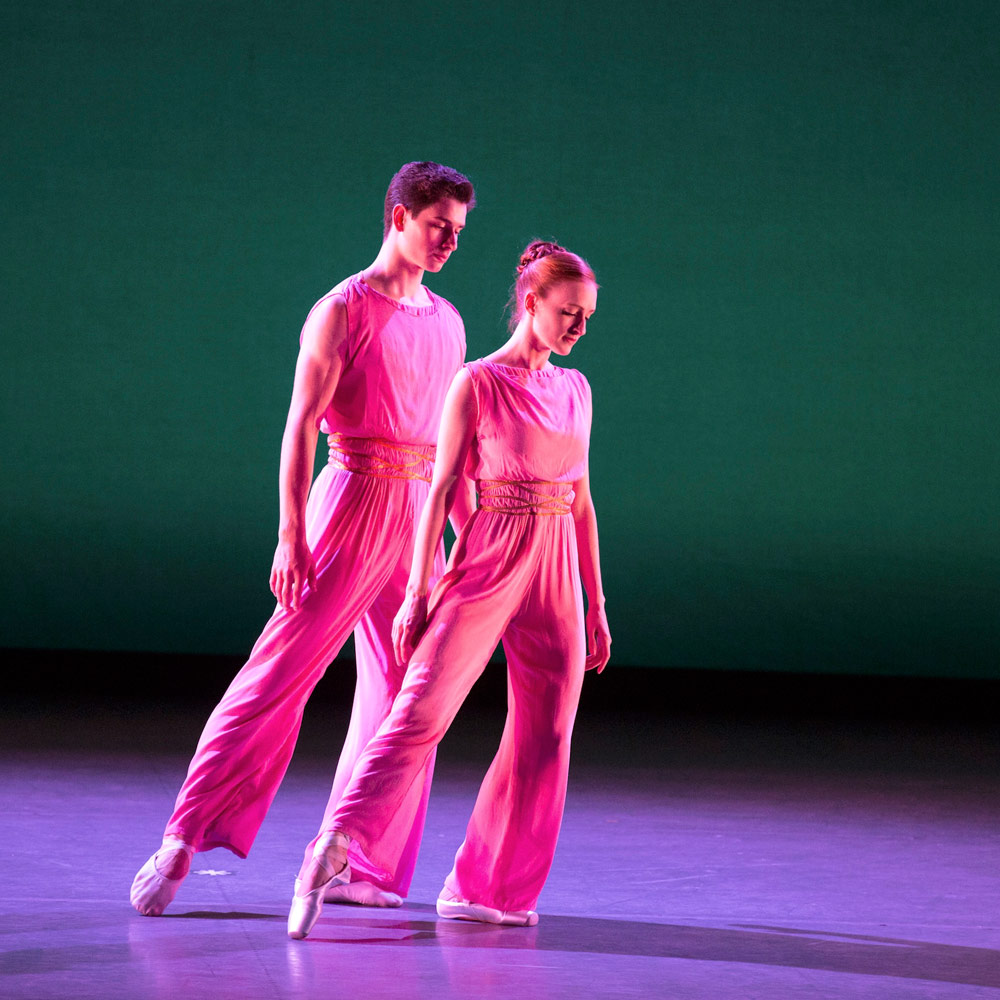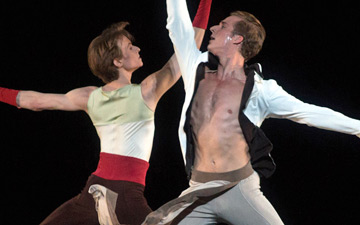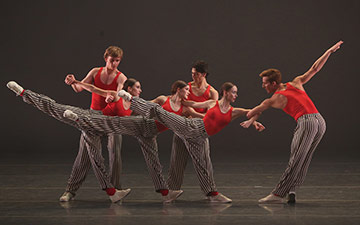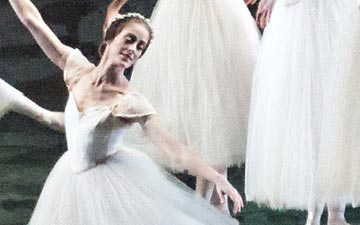
© Rosalie O’Connor. (Click image for larger version)
American Ballet Theatre
Fall Gala: After You, Monotones I and II, The Brahms-Haydn Variations
New York, David H. Koch Theater
21 October 2015
www.abt.org
Classicism Three Ways
American Ballet Theatre, which is now entering the final stretch of its 75th anniversary year, opened its fall season on Oct. 21 with a triple bill at the David Koch Theatre. If springtime at the Met is the time to surrender to the grandiloquence of big three-act story ballets and the fulsome charms of individual stars, the fall is where one really gets to know the company. Everybody dances, and the corps de ballet dancers come out of the shadows. They make the most of it.
ABT galas are more laid-back than City Ballet’s; they’re less “produced,” with fewer speeches or slick video presentations. For the most part, the company just gets on with the show, with minimum fuss. (In contrast, the patroness’s dresses tend to be more voluminous. These ladies like to make a big entrance.) Tonight’s program was well worth getting on with: a new work by Mark Morris (After You), the company première of Frederick Ashton’s Monotones (I and II), and a revival of Twyla Tharp’s Brahms-Haydn Variations, last performed here in 2010.
It was fascinating to see this triptych so soon after the end of City Ballet’s fall season, which featured works by four choreographers still in their twenties. In contrast, all of the works in the ABT gala program were created by mature artists, and it showed. With the exception perhaps of the Tharp piece – which is dazzling and busy and in its way quite showy – they had far less to prove. The focus, instead, was on details of style, intent, and theme. Morris shows us an ideal society characterized by collegiality and decorum. Ashton’s Monotones delves into the mysteries of line – the geometries of the body – and of seamless, continuous movement. Tharp fills the stage with activity, refracted and multiplied as in a kaleidoscope. All three are explorations of classicism.
Everything in Morris’s After You is modest, from the crisp, melodic and formally satisfying music of Johann Nepomuk Hummel – specifically the three first movements of his Septet in C Major, No. 2 – to the silky, loose, unisex jumpsuits by Isaac Mizrahi and the attitude of the dancers. All mannerisms and tricks have been stripped away. The ballet is constructed out of basic ballet steps, low, rounded arms, modestly-raised legs, small jumps, slow, clean turns. Once again Morris proves that a dance doesn’t need to be overstuffed or jazzed up to look full. He introduces a series of motifs, linking them to the different voices in the music: cello, clarinet, violin, trumpet. When the motifs return, we recognize them, like old friends: there is that pretty arabesque-pivot-forward-tilt we saw before; and here is the little leap, and the renversé sequence. The title of the dance alludes to one of these motifs – a palm held out as if to say, “go ahead, be my guest.”
The company looks wonderfully relaxed here. In the adagio second movement, the new soloist, Jeffrey Cirio, (formerly of Boston Ballet) dances a beautiful, unadorned solo that begins with a slow, pensive promenade. Soon, he is joined by Sterling Baca; both bow deeply and then spin, again slowly, once or twice rather than the usual four or five times. In the third movement, Gillian Murphy and Stella Abrera turn, supported by their partners, unfolding their legs in every direction. Eventually all the women do it. When the phrase comes back in pianissimo, Murphy returns and repeats the same phrase, alone, as if the quietness of the music could only support a single dancer, not two. The ballet’s calm demeanor lifts only once when Calvin Royal III bursts across the stage on the heels of a trumpet fanfare – the Hummel piece has a “military” flavor – and launches into a series of barrel jumps, the last one tumbling to the floor.

© Rosalie O’Connor. (Click image for larger version)
Ashton’s Monotones proved more of a challenge. In these two trios, performed in form-revealing unitards to absolutely limpid music by Satie, there is nowhere to hide. (The first ballet is set to the Gnossiennes, the second to the Gymnopédies, orchestrated by Debussy and others.) Every wobble, every difference in musicality, every awkward transition shows. These works from the mid-sixties are Ashton’s response to the pared-down classicism of Balanchine, the finger-tip partnering, the spaciousness of movement, the use of daisy-chains and interweaving. Even the final pose in the second work, which is danced by two men and one woman, could be seen a modified version of Balanchine’s “sunburst” from Apollo, except that here the legs are kept low.
Both of the Monotones ballets are deeply mysterious; when we first see the dancers, they are shielding their faces from an otherworldly light. In their long-sleeved, uniform-like costumes, they look almost like astronauts – Ashton said more than once that he was inspired, at least in part, by space exploration. The dancers walk, toward and away from each other, like pilgrims lost in an empty, serene landscape beyond time. The focus is on shapes and lines: a perfectly-held arabesque multiplied by three, or a slow unfurling of the leg while hovering in a plié.
The first ballet, danced by Stella Abrera, Isabella Boylston, and Joseph Gorak, contained more than a few wobbles and an imperfect synchronicity. Boylston was slightly ahead of the beat, Gorak slightly behind, and Stella Abrera just right. In the second, Veronika Part was partnered by two men, Thomas Forster and Cory Stearns. It was striking – and beautiful – to see how alike they were in size; Part is tall (especially on pointe) and broad-shouldered, with a powerful back. But the opening, in which the two men raise Part off the ground with her leg held up to her head, then slowly turn her between them, wasn’t executed smoothly enough to create the illusion of continuous movement. The ballets will need more time to settle.
Twyla Tharp’s Brahms-Haydn Variations, which came next, is the perfect closer: an explosion of movement, a sea of arms and legs, like Symphony in C, Theme and Variations and The Four Temperaments all rolled into one. There’s too much to see at once. As soon as the eye wanders from one of the main couples, it notices four things going on behind that are just as interesting. People are constantly rushing on and off. Gillian Murphy, partnered by James Whiteside, is the queen of this busy reign, relaxed and authoritative and apparently having a pretty good time. (In a game of tag, Whiteside tries to catch her, but he can’t keep up.)
But then, all the women shine in this ballet, which, like its Balanchinean models, is more about them than it is about the men. (Though the men do get to swing the women around a lot.) Boylston and Sterling Baca – who looks like the happiest man on the stage at all times this season – engage in a playful leaping competition, which then leads into a series of fouetté turns for her (because, why not?). Maria Kochetkova floats across the stage in Herman Cornejo’s arms, barely touching the floor with her rubber-band-like legs (does she have bones?). And then, at the end, come the fireworks.
Brahms-Haydn is crammed with a little bit of everything. Tharp is no minimalist. How she keeps it all together is anyone’s guess, but it’s certainly fun, if a little dizzying, to watch.

















You must be logged in to post a comment.